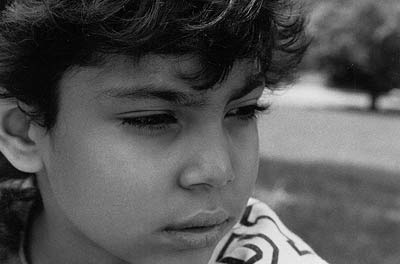This 30-page photo-essay, funded by The National Center on Family Homelessness and IBM Corporation, explores the lives of three preschoolers assisted by the ‘Kidstart’ program. 1991.
The following text and photographs are excerpts from “Homeless Children in the Kidstart Program”.

Luisito
Luisito cares about creatures of all sizes. He worries about bedraggled, skinny cats, and spends hours searching for the families of bugs that seem lost. His mother keeps an eye on his toys when he plays with other children. “He shares them too much,” she says.
For much of the past year, Luisito has remained inside his apartment in South Worcester. He stays there with his 23-year-old mother, Iris, his baby sister, and his grandmother, because the streets are not safe for playing. Iris keeps the shades pulled down all the time, so the second-floor rooms are dark. She says she finds the view very depressing.
Last fall, Luisito was unable to separate from his mother and go to kindergarten. Says Iris, “I brought him to school last September, but he didn’t like to go by himself. Like, the first day he went after his teacher. He slapped her, pulled her hair, kicked her. She had told me to leave, and she was nice about it, but I guess the way she said it didn’t sound right to him. He was just petrified.

Christopher
Taking pictures of Christopher is a challenge. Some are no more than the blur of a striped rugby shirt; a scooter rounding the corner and dispapearing from view; a shielded face and a grimace — “no photos today!” Christopher is in constant motion, not only physically but in expression, in mood. Releasing the shutter becomes an exercise in prediction.
Christopher has lived at Medford Family Life, a transitional shelter for families, for about ten months. Owner of a quick tongue, a remarkable memory and a highly developed sensitivity to the ’unfair,” Christopher seems destined to become a laywer — that is, if he can control his emotions. Everyone marvels at his improvement in this respect, testimony in part to his mother’s increasingly sophisticated ability to care for him.

Tikia
For about two months now, Tikia has been living in the Paul Revere Motel with her mother, Racine, and younger sister Savadra. Except for the dolls, there are no signs of childhood in Tikia’s environment. Her street is a vast industrial and commercial sprawl commonly veiled by a thin, unnatural haze. Most days are spent watching television; the best days include a trek to a deserted playground on the other side of a four-lane divided highway.
Tikia has created a repertoire of nonsense rhymes and giddy dances, and is eager for an audience. Considerate, inquisitive, quick to laugh — Tikia has many charming qualities. she longs to hold hands, ride piggyback, sit on laps. But when she talks, it’s often hard to understand her. Her attemtps to communicate are an earnest but garbled flow of sounds. Despite all efforts to make contact, Tikia seems profoundly alone.